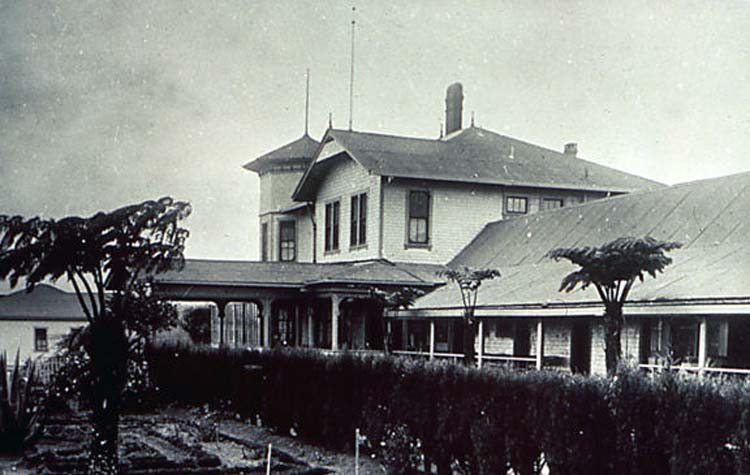He was known as “Pele’s Grandson” to many – and “The Runt” to his boss, Thomas R Boles, Superintendent of the Hawaiʻi National Park (he was 5-foot 1-inch in height and weighed ninety-five pounds.) (NPS, 1953)
Alexander P Lancaster (aka Alex or Alec,) a Cherokee, was employed by Volcano House and Hawaiʻi Volcanoes Observatory, guided tourists to Kilauea’s active lava lake from 1885 to 1924. (Wright)
Lancaster was a firm believer in Pele and her powers; he took a proprietary interest in the volcanoes – thus the nickname. He enthralled thousands of visitors with his intimate knowledge of volcanoes.
When someone mentioned Vesuvius to him, his stock reply was, “Vesuvius is just an old man. Pele is sturdy on her job.” It was nothing short of a sacrilege to talk about other volcanoes in Alec’s presence. (NPS)
An interview with “Uncle George” Lycurgus Volcano House owner (on his one-hundredth birthday) reveals more on Pele. When asked if he had ever seen Pele, Lycurgus replied:
“Oh, yes. I tell you. I saw Pele, in the fire. There is a woman … you can see a woman, in the flames … she comes out and walks around … then she goes back in the fire … and prays ….”
“The Hawaiians believe in Pele. Certainly I believe in Pele, too. Pele belongs to the Islands. She will come to tell us what to do. She always comes when we need her. Pele is bound to come soon.” (Nimmo)
When Halemaʻumaʻu was inactive and business at the hotel was poor, Lycurgus decided to offer prayers and rituals at the volcano to coax the goddess back to the crater and thereby improve business at the hotel.
He and Lancaster “walked down to Halemaʻumaʻu and invoked some prayers to the volcano goddess. Following that, they tossed into the fire pit an Ohelo berry lei made by Lancaster … “
“As a final gesture, Lycurgus tossed in a bottle of gin which had been partially drained by him and Lancaster on the walk to the pit. More prayers followed and the two of them returned to the Volcano House for the night. Within hours after the men went to bed, the volcano began erupting.” (Nimmo)
“Alec Lancaster, the well-known guide at the crater, has made a trail to a ledge of pahoehoe, a distance of 200-feet from the brink, and takes down to that point those visitors who desire to make a closer inspection than can be made at the edge. So far not many have shown a willingness to accept Alec’s invitation.” (Evening Bulletin, June 15, 1902)
Thomas Augustus Jaggar, Jr was an American volcanologist; he founded the Hawaiian Volcano Observatory and directed it from 1912 to 1940.
“Lancaster, probably wound up each trip into Kilauea caldera with one pocket full of tips and another full of Cuban cigars – until Jaggar put him on the Observatory’s payroll as janitor, guide and general roustabout. Lancaster’s experiences close to Kilauea’s flowing and fountaining lava made him a good hand for Jaggar.” (USGS)
“Once again, in the interest of science, Madame Pele has been braved by the investigators living on the volcano’s brink for the purposes of studying systematically the vagaries of the fire goddess and of reducing her phenomena down to rules of cause and effect.”
“Last week, while the pit of Halemaʻumaʻu was in a state of unusual activity, with lava fountains playing, spatter cones forming, streams of liquid fire swelling in flows over the hardened crust…”
“Dr ES Shepherd, of the Geophysical Laboratory of the Carnegie Institution, and HO Wood, technical assistant of Professor Jaggar, accompanied by Alex Lancaster the veteran Volcano House guide, descended four hundred feet into the pit, crossed the hardened but heated lava floor and collected sufficient of the nascent gas from one of the open vents for analyses.”
“Rope ladders were used to descend the first one hundred and eighty feet of the pit, for which distance the walls are sheer. At this depth the walls were broken down and the intrepid scientists and their daring companion were able to scramble down the rest of the way to the fire level, over the smoking, crumbling lava.”
“During the greater part of their descent, the three were hidden from the view of those who tried to watch them from the pit’s rim by the swirling, opaque gases that swept in clouds over the surface of the lower levels. (Hawaiian Gazette, December 10, 1912)
Alec’s thirst for liquor was his undoing; he was dismissed from the Park in 1928. He spent his last years as a public ward in the Old Folks’ Home in Hilo. (NPS) (Reportedly born in 1861, Lancaster died in 1930.)
























































